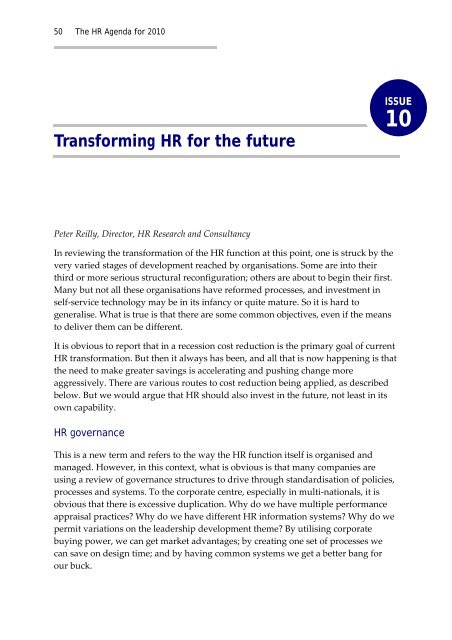PDF of this item - The Institute for Employment Studies
PDF of this item - The Institute for Employment Studies
PDF of this item - The Institute for Employment Studies
- No tags were found...
Create successful ePaper yourself
Turn your PDF publications into a flip-book with our unique Google optimized e-Paper software.
50 <strong>The</strong> HR Agenda <strong>for</strong> 2010Trans<strong>for</strong>ming HR <strong>for</strong> the futureISSUE10Peter Reilly, Director, HR Research and ConsultancyIn reviewing the trans<strong>for</strong>mation <strong>of</strong> the HR function at <strong>this</strong> point, one is struck by thevery varied stages <strong>of</strong> development reached by organisations. Some are into theirthird or more serious structural reconfiguration; others are about to begin their first.Many but not all these organisations have re<strong>for</strong>med processes, and investment inself‐service technology may be in its infancy or quite mature. So it is hard togeneralise. What is true is that there are some common objectives, even if the meansto deliver them can be different.It is obvious to report that in a recession cost reduction is the primary goal <strong>of</strong> currentHR trans<strong>for</strong>mation. But then it always has been, and all that is now happening is thatthe need to make greater savings is accelerating and pushing change moreaggressively. <strong>The</strong>re are various routes to cost reduction being applied, as describedbelow. But we would argue that HR should also invest in the future, not least in itsown capability.HR governanceThis is a new term and refers to the way the HR function itself is organised andmanaged. However, in <strong>this</strong> context, what is obvious is that many companies areusing a review <strong>of</strong> governance structures to drive through standardisation <strong>of</strong> policies,processes and systems. To the corporate centre, especially in multi‐nationals, it isobvious that there is excessive duplication. Why do we have multiple per<strong>for</strong>manceappraisal practices? Why do we have different HR in<strong>for</strong>mation systems? Why do wepermit variations on the leadership development theme? By utilising corporatebuying power, we can get market advantages; by creating one set <strong>of</strong> processes wecan save on design time; and by having common systems we get a better bang <strong>for</strong>our buck.
















